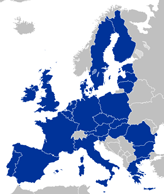Wide Variation in Cancer Survival Among European Countries
A study of cancer registry data from 29 European countries shows major improvements in both cancer diagnosis and treatment as well as large differences in outcomes for cancer patients depending on the country where treatment took place.
A study of 29 European countries found large differences in outcomes for cancer patients depending on where treatment took place.

A study of cancer registry data from 29 European countries shows major improvements in both cancer diagnosis and treatments as well as large differences in outcomes for cancer patients depending on the country where treatment took place. The study, published in Lancet Oncology, analyzed the 5-year survival rates of almost 10 million adults diagnosed with cancer in Europe between 2000 and 2008.
Overall survival rates were highest in Northern, Central, and Southern Europe and lowest in Eastern Europe. Five-year survival was higher for those patients diagnosed between 2005 and 2007 than for those diagnosed between 1999 and 2001.
As part of the EUROCARE working group, Roberta De Angelis, MSc, of the Istituto Superiore di Sanità in Rome, and colleagues retrospectively analyzed 107 cancer registries, calculating country-specific and age-specific survival for the 10 most common cancers and 5-year relative survival for 46 cancers.
The number of adults surviving their cancer diagnosis for at least 5 years has been steadily on the rise in all parts of Europe, due to advances in both cancer management as well as diagnosis and screening, said Angelis, in a statement. The largest increases in survival were for prostate cancer (from 73.4% in 1999 to 2001 to 81.7% in 2005 to 2007), non-Hodgkin lymphoma (NHL; 53.8% in 1999 to 2001 to 60.4% in 2005 to 2007), and rectal cancer (52.1% to 57.6%).
"The most likely reasons for improved survival for NHL and rectal cancer are more effective drugs and better surgical techniques, whilst earlier diagnosis as well as detection of indolent cancers and overdiagnosis-owing to the increasing use of prostate-specific antigen testing-explains the dramatic increase in numbers of patients surviving prostate cancer,” said Angelis.
For ovarian cancer and cancers of the central nervous system, survival was not improved.
The differences in survival among European countries are only narrowing for a few select cancers: breast, rectum, prostate, and melanoma.
Countries with the lowest cancer survival are all in Eastern Europe and include Bulgaria, Estonia, Latvia, Lithuania, Poland, and Slovakia. The 5-year survival rates for cancer patients in these countries are all below the European average, including for cancers that generally have a relatively good prognosis: 49% vs 57% for colon cancer, 45% vs 56% for rectal cancer, 50% vs 59% for NHL, and 74% vs 83% for melanoma, respectively.
The United Kingdom and Ireland also had shorter survival among adults with cancer compared with the European average for common cancers, including ovarian (31% vs 38%), colon (52% vs 57%), and kidney cancer (48% vs 61%). The United Kingdom and Ireland had survival rates on par with the European average for cancers of the rectum, breast, prostate, melanoma, and lymphomas.
The authors attribute the differences in survival among countries to differences in timing of diagnosis, accessibility to good cancer patient care, differences in screening and diagnostic frequencies, and potential differences in cancer biology. “Variations in socioeconomic, lifestyle, and general health between populations might also have a role,” conclude the authors.
In a commentary accompanying the publication, Alastair J. Munro, of the cancer research division at the University of Dundee School of Medicine in the United Kingdom, writes that only through analysis of detailed information, can factors linked to major improvements seen in diagnosis and treatment of cancer allow for progress in improving cancer outcomes. Surveillance-based analysis over time using US data has shown that “a third of the reduction in prostate cancer mortality is a result of screening, and a further third is a result of advances in treatment,” he noted.
To make sense of “big data,” detailed information such as sociodemographics, staging, treatment, recurrences, subsequent line therapy, and precise information on the cause of death are needed in registries, Munro writes. He concludes that “until more is known about the individual attributes of patients, the interpretation of the EUROCARE studies will be far from straightforward.”
The point of large data set studies such as this one is to identify the key positive and negative trends that can lead to programs that support improving trends and practical programs that improve patient care.
Newsletter
Stay up to date on recent advances in the multidisciplinary approach to cancer.